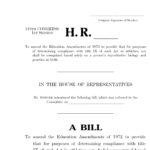
The issues of gender and sex continue to become more and more ambiguous in our society, leaving the terms “male” and “female” open to individual interpretation so that marking a box to indicate one’s sex has become very subjective. Failure to clearly define what is meant by those terms in our policies and procedures leaves our District open to misunderstanding by students, employees, and parents. All 3 of our nation’s branches of federal government, the judicial as well as the executive and legislative branches, are taking steps to define those terms based strictly on physiological make-up, and our state legislature has similarly defined them as recorded on the original birth certificate. These definitions align with our community’s values. This most-locally controlled political subdivision known as Ozark School District needs to also align itself with the law – and the community – and define them here as well.
I again propose that the Board discuss adopting some version of the following addition to our Title IX policy:

The terms “gender” and “sex” have been frequently used interchangeably in society, therefore the District clarifies that the intent of either of those words throughout the District’s policies and other written documents should be understood to mean “physical, chromosomal sex,” and, in every decision requiring a distinction between the two, the differentiation will be based on physical, chromosomal sex as recorded on the student’s original birth certificate.
As discussed briefly during the December board meeting, the Board has been advised that even discussing that Proposal would be illegal, based on an Appellate Court decision in a Blue Springs School District Case.
Let us examine the facts in that Blue Springs, MO case, as delivered in the Western District Missouri Appellate court’s opinion on June 4, 2024, and then compare its applicability to the above Proposal for Ozark, MO.
- In 2009, a female student in the Blue Springs School District transitioned to a male identity in the 4th grade, at the age of 9. She was given hormone blockers and puberty blockers beginning in the fall of 2011, when entering 6th grade.
- In 8th grade, during the 2013-2014 school year, the student, known in court papers as R.M.A., participated in boys’ PE classes, played football, and ran on the boys’ track team. Despite the mother’s request, however, the District did not permit R.M.A. to use the boys’ facilities – without ever providing specific reason other than to suggest it was related to her female genitalia. The court noted that the District testified that it did not ever inspect her genitalia, nor does it inspect other students’ genitalia for determining facility usage. This alleged reliance on genitalia was one of the main objections argued in the student’s forthcoming charges of discrimination based on sex, and one which the court noted as being clear evidence of discrimination based on sex because of sex stereotyping (pp. 26ff.)
- In 9th grade, during the 2014-2015 year, now at a different building, R.M.A. did not participate fully in PE nor in athletics, stating that the reason was that the school denied the use of male locker rooms. The high school principal testified that, although there was no written policy, the determination was then made based on R.M.A.’s birth certificate already on file with the District. An assistant superintendent testified that it was “a matter of practice” to use birth certificates (p.30.)
- In December of that year, R.M.A.’s mother presented an amended birth certificate, but, as the court noted, the usual practice was not applied, and the District continued to deny R.M.A. access to boys’ facilities. R.M.A.’s family then brought suit, alleging discrimination on the basis of sex (not transgenderism, the MO Supreme Court noted) because public male facilities were available to boys, but not to R.M.A. The court noted that the unwritten state of the District’s policy – and its refusal to follow it consistently – was evidence of “reckless disregard of R.M.A’s rights.” (p.33)
- One last incredulous point highlighted in this court decision was that R.M.A.’s mother tried unsuccessfully for years to work with the School District, but was not granted an audience. This was also a major factor in the court decision.
These issues were highlighted throughout the document, but in its conclusion on pp.32-33, the Appellate court opinion unequivocally declared,
The evidence at trial, viewed according to our standard of review, was that School District had an unwritten policy of using birth certificates to determine sex. Yet, School District refused to tell R.M.A.’s mother that it would honor a corrected birth certificate stating he is male because School District wanted to keep its options open in the event R.M.A. was able to obtain a corrected birth certificate. R.M.A.’s mother tried repeatedly for years to work with School District to resolve R.M.A.’s issues. The superintendent refused to meet with her. The school board refused to meet with her. Instead, School District tried to placate R.M.A.’s mother with empty words. The School Board did not change its position or policies in the years between the filing of R.M.A.’s petition and the trial. This is sufficient evidence that School District acted with reckless disregard of R.M.A.’s rights. (emphasis mine)
We see four main problems above which were the impetus for the decision of “discrimination”:
- the absence of any written policy
- confusion about criteria used for determining usage of facilities, resulting in the appearance of discrimination based on sex stereotyping
- refusal to adhere to the existing practice, albeit an unwritten one, which was used for other students
- refusal to meet or work with the parent
Now, note the stark difference in this case with the Proposal for Ozark to discuss an addition to clearly define in written policy what standard is to be used for every student. Without the Proposal, two of the court’s very specific objections to the Blue Springs School District’s actions are actually being practiced in Ozark right now.
Adopting some version of the Proposal would eliminate those main problems the court named in its decision:
- it would fix the problem of establishing a policy in writing
- having it in writing would eliminate confusion and enable equitable enforcement for all students
- it creates a path for any parent to be able to discuss the policy with the administration and/or the board.
Clearly then, in my opinion, this topic needs to be discussed and defined because failure to do so leaves Ozark aligned with the very actions specifically condemned by the court in this case against Blue Springs School District.
Lastly, as an aside, consider the question, What if we don’t? What if we just let students self-report their sex? What if we do not provide any clear direction for those making determinations regarding when or whether a student’s sex changes, as happened in this case? As the court recited in its decision but not mentioned above since it was not a determining factor, leaving the sex of the student ambiguous – up to the student’s changing inclinations – caused a third party which was handling the lodging for an overnight trip to assign R.M.A., a biological female, to room with biological males.
*I say “biologically female” because testimony recorded in the court’s opinion reported that R.M.A. possessed XX chromosome and female reproductive organs. The testimonies of the medical experts in that case differed, but, one such expert testified that R.M.A.’s sex should be considered male despite those physical female characteristics, because, in that doctor’s opinion, the decision of choice of sex is up to the individual. (pp.15ff)
Again, room assignments in overnight lodging was not necessarily a determining factor in the overall court decision, but I mention it here because it was recorded in the opinion, and it certainly illustrates one danger of failing to clearly define in written policy – instead of “accepted practice” – how the district determines a student’s sex/gender.
As always, I speak only for myself and do not at all intend to represent the Board to you.
I do, however, fully intend to do my job representing YOU to the Board!